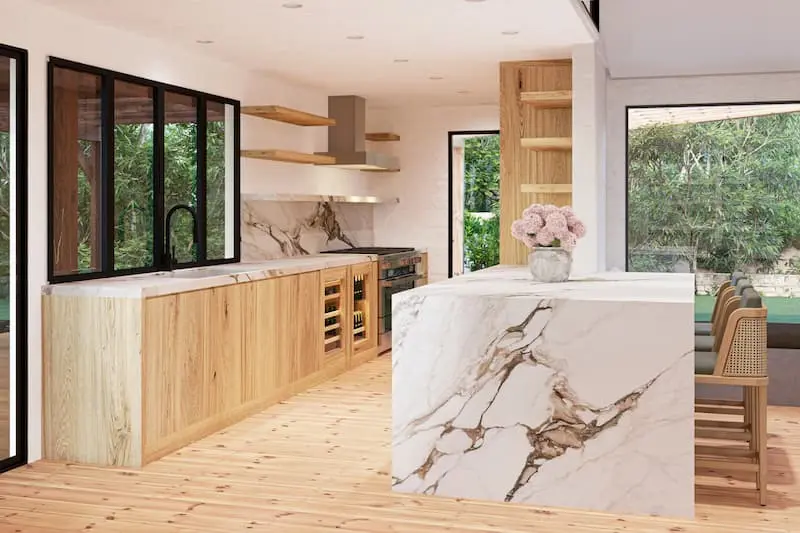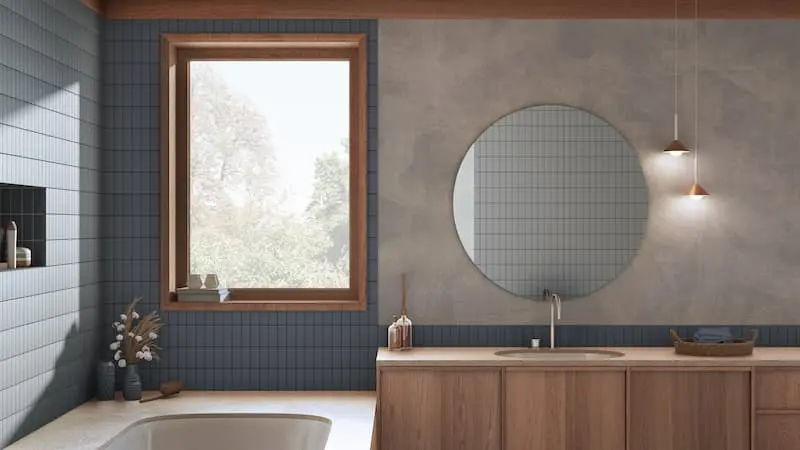Lured by warm woods, earthy colors and a minimalist, calming vibe, homeowners are embracing Japandi design. This decision is largely due to its tranquil aesthetic, but because it also contributes to health and wellness at home and supports sustainable choices.
Japandi design embraces the concept that home is meant to be a sanctuary from chaos in the outer world, offering a built environment that promotes rest and relaxation with key design elements.
What is Japandi design?
“Japandi design combines Japanese minimalism with the functionality of Scandinavian design. Incorporating natural materials in a clean, uncluttered design introduces Japanese concepts like wabi-sabi, which finds beauty in imperfection to create a serene and inviting space,” says WELL and LEED accredited interior designer Sarah Barnard.
Japandi’s influences draw from Danish-based Hygge. Hygge goes beyond a curated aesthetic to prescribe a lifestyle where gratitude, cozy, calm, togetherness with loved ones and mental and physical health are priorities.
In addition to good-for-you activities, such as immersing in nature and mindfully enjoying the company of loved ones, Hygge includes products and home décor. These combine to foster awareness, gratitude and peace and include fashion, furnishings, materials, and simple design principles.
A Hygge-styled home features rustic woods, for their simple but meaningful contribution to décor and a largely monochromatic color mix, with an emphasis on cozy textiles and a connection with nature.
Meanwhile, the Japanese philosophy of wabi-sabi is inspired by the authentic beauty of imperfection, the power of being mindful and present, and going with the flow of life cycles and nature. It is also influenced by the elegant minimalism of traditional Japanese cultural style.
In an interior design context, with wabi-sabi, design choices must be intentional and purposeful. For example, there is a lack of wasted space, as well as decorative pieces that don’t offer a dual purpose, either practically or emotionally.
Japandi design fuses these elements from Hygge and wabi-sabi to create function-first, sustainable design for a sanctuary at home.
Why is Japandi design so popular right now?
One of the reasons that Japandi design is so popular is due to the way it mingles with other hot décor trends, including biophilia, fusing indoor/outdoor connections through design and creating spaces that support health and wellness at home.
“Today’s homebuyers are interested in functional indoor/outdoor living spaces that are tranquil and feature natural elements, which are the core philosophy of Japandi design,” says Brad Blank, president of Tri Pointe Homes’ DC Metro Division.
Also, as Blank explains, the design trend is growing alongside homeowners’ desire to create beautiful multi-purpose spaces to support live/work/play/learn at home.
“Many remote workers also love Japandi because its approach to minimalism and simplicity creates a clean, uncluttered space and promotes a sense of mindfulness and intentionality,” says Blank.
Japandi design, Biophilia and health and wellness
“Biophilic design, a key aspect of Japandi design, inspires mindfulness and contentment through our innate desire to connect with nature,” says Barnard.
“Incorporating unique natural materials such as wood paneling, beautiful stone countertops, and large windows that provide ample natural light creates bright indoor spaces. This promotes a sense of calm by establishing a tangible connection to the surrounding environment,” she says.
In addition to leaning heavily on natural materials and a minimalist aesthetic, Japandi design encourages timeless choices versus trends, with a focus on craftmanship and quality, all of which combine to reduce homeowner footprint.
“By advocating for fewer, multifunctional pieces, Japandi promotes mindful consumption. The use of eco-friendly materials such as wood, bamboo and natural fibers, combined with high-quality, durable furniture and decor, ensures longevity and reduces the need for frequent replacements,” aiding with sustainability, says Blank.
Japandi design style tips
As an overarching theme, Japandi design starts with making intentional choices that stimulate the senses and encourage you to be present in a peaceful environment.
Here are some style tips:
Smart storage
With a focus on clean lines, easy accessibility and no clutter, storage is an essential component of Japandi.
Wooden storage is ideal, made of warm wood with texture, such as oak, maple or walnut. A wooden sideboard with textured cabinetry, or built-in shelving with fluted cabinet fronts are both stylish choices.
Also look at ways to incorporate storage (and cut down on clutter) in multi-purpose furniture, such as with lift-up ottomans, coffee tables, or under-bed storage.
Color scheme
Japandi is mostly monochromatic, and muted, although you will see variations. The main colors are earthy and warm, such as browns, beiges, creams, ivories, with soft nature-inspired blues and greens.
Natural materials
Japandi design relies less on color for aesthetic impact, and more on material choices that layer with visual interest. Natural materials add to the calm vibe, while adding that subtle but striking texture. Stone, bamboo and rattan are all popular.
One of the most-used materials is wood, for flooring, furniture and as a way of introducing natural color and warmth into a space. Wood-slatted walls, wooden cladding and fluted details are all stylish.
Take advantage of Zen vibes of Japandi in the primary bath, with a stone tub or tile. Wood-look tiles are also popular. In the kitchen, combine natural stone countertops with bamboo flooring.
Invest in quality
The Japandi vibe is slow and steady, with a respect for the authenticity that comes with time. Invest in higher-quality furnishings and accents that feature excellent craftmanship and timeless style. It’s worth spending a little more for something that will last, and focus on main pieces, such as sofas, dining tables and bedroom furniture.
Fuse indoor/outdoor connection
Establishing a strong awareness of nature, even while indoors is an important part of Japandi style. Keep window treatments to a minimum. Opt for sliding glass doors or retractable walls. Choose indoor/outdoor flooring that can extend from the inside out for design continuity. Be sure to incorporate plants and greenery inside, for color, and to mimic the experience of being outside.
Soft lighting
Choose lighting that casts a soft glow for cozy ambience, such as paper lanterns and fixtures made from natural materials, such as rattan, with sleek and minimal, but warm, profiles. Choose LED bulbs to make fixtures sustainable.
Textured décor
Lean into texture, both tactile and visually, when choosing textiles. Choose plush seating, covered with natural linen or bouclé, along with accent pillows and a selection of cozy throws spread across seating, inviting you to curl up and relax.
Elect for décor choices that offer an authentic patina, such as live-edge tables or unique earthenware for accents.
Wall décor
In keeping with the minimalist vibe, walls should be relatively bare, except for a few well-placed pieces of artwork. Go for black and white, or textured pieces fashioned from natural materials, such as wood, plants or seashells.









